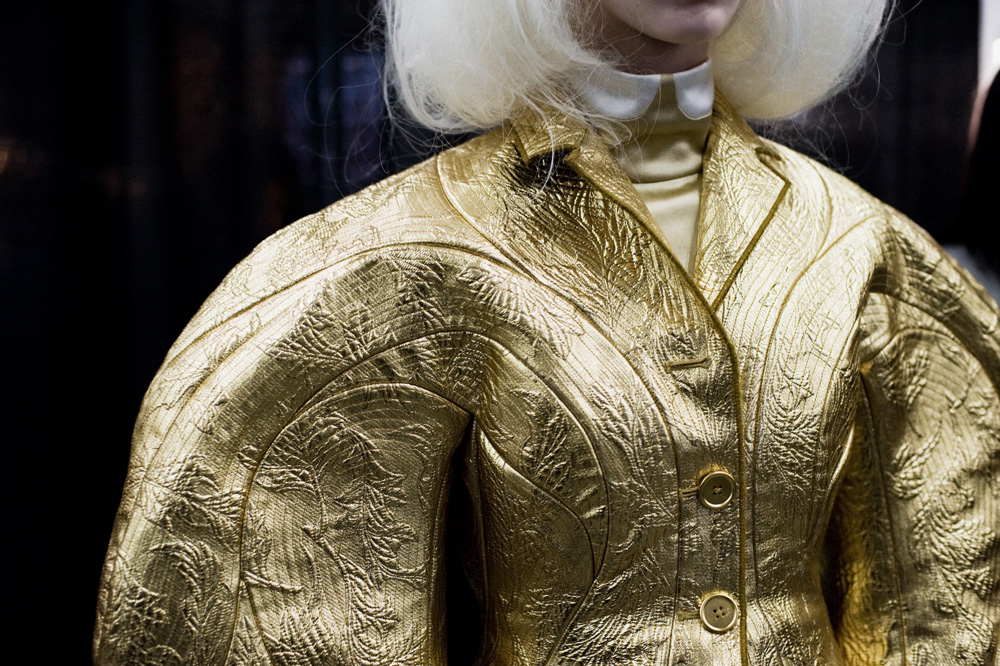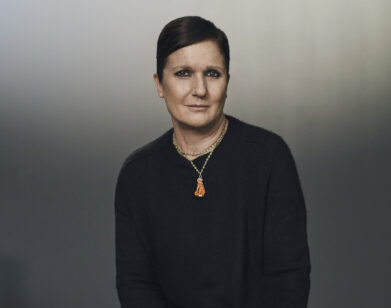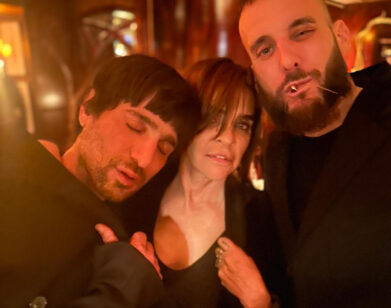Thom Browne
It’s New York Fashion Week and seasoned Interview photographers Shawn Brackbill, Christopher Gabello, Kate Owen, and Pablo Ravazzani are backstage and front row at our favorite shows. Check in daily and follow Shawn, Chris, Kate, and Pablo on Interview‘s Twitter, Instagram, and Facebook, for the latest updates.
Backstage before his show last night, “ecclesiastic” was the simplest way Thom Browne could describe his Fall 2014 collection. “Heretic” might have also worked. The scene he set (because Browne always sets a scene) was the dark, incensed interior of an old Catholic church, awash in the dim red light that backlit the giant crosses hanging from the walls. The congregation, who waited a dutiful 45 minutes for the first look to walk out, did so in wooden pews. “This season I was watching a lot of films by Fellini,” Browne said. “I was really drawn to Roma,” he explained, a film that features a surreal clerical fashion show.
The soundtrack from Fellini’s fashion show, heavy on the organ, announced the opening look at Browne’s: a chaste, floor-length, form-obscuring gray cape. Something more carnal and less pious immediately followed: a voluptuously tailored skirt suit in the same color. “I was really focused on the shoulder and hips,” the designer confirmed. The hyper-exaggerated curves they created on the body fell somewhere between sensual and unsettling. This was Browne’s edit on Sunday best.
The show, in which models walked at a ceremoniously slow pace, vacillated between these two fetishes—chastity and sensuality—to the point that they coalesced. The procession descended from gray into black, and then out of monochrome purgatory into a series of rich golds, all while the organ crept, counterintuitively, into a deeper and darker, more sinister register. “It was really important to me to find genuine gold lamé from the ’30s,” Browne told us, because today’s synthetics wouldn’t have evoked the same decadence. The excess of it all—the beading, the quilting, the fur, the devoré fabric treatments—was rapturous, but one wasn’t sure whether Browne’s cast of churchgoers were bound for heaven or, as the lurching score more likely suggested, hell.
The last look to step out, all by itself on an elaborate, elevated runway, was disarmingly simple: a languorous gold shirt-dress that looked more contemporary than costume-y. Was this an analogy for religious hypocrisy? It hit weirdly close to home. Also disarming, but sort of hilarious, was the way that 10 minutes of somber organ music transitioned seamlessly to the more modern “Sister Marie Says,” a techno-gospel-rock number by Orchestral Manoeuvres in the Dark, for the finale. “Call yourselves believers and you’ll all be fooled again,” the frontman wailed.
As an end to the spectacle he’d just put on, that little gold dress and the club music that followed it posed important questions to Browne’s audience: what’s to distinguish our fashion shows from Fellini’s, or the sanctimony of the church from the fashion industry’s? In Roma, the Pope himself closes the show in an opulent white and gold get-up as his followers, clutching their lesser earthly jewels, gush on in ecstasy. Browne’s runway was an extravagant, abstract image, too. The lamé in stores will not be vintage, those severely rounded shoulders might not make it into the real world, and none of it will look quite as divine as it did when it walked. But people will pay trying to recreate it. “I think the fantastical element of the show,” he offered, “is what makes the commercial pieces appealing.” There was a biting metaphor for fashion as religion.
Maybe that was why you heard fewer people spurt “to-die-for” and other devotional overstatements as they filed out of the venue—a sense of sobriety from zealotry. (But maybe they were just rushing to their next sermon, at Donna Karan or The Row.)
For more from New York Fashion Week Fall/Winter 2014, click here.







